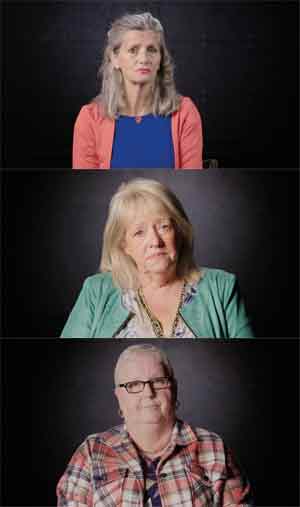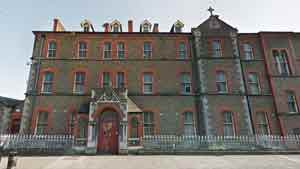IRELAND’S DIRTY LAUNDRY
Published in Issue 4 (July/August 2022), Reviews, Volume 30RTÉ1, 2 and 9 February 2022 Directed by Gerry Gregg and co-produced by Gregg and Nuala Cunningham
By Sylvie Kleinman

Above (Top): Interviewee and survivor Gabrielle O’Gorman—‘England was my saviour, it was my freedom, away from the Catholic Church, the nuns, and the State’. (RTÉ). Above (Center): Interviewee and survivor Maureen Sullivan praised her ‘Scottish’ counsellor, who helped her to use the actual words qualifying the abuse which had led her to the laundry: ‘sexual’ abuse of an innocent little child. (RTÉ). Above (Bottom): Interviewee and survivor Teresa O’Connor—‘we [viewers] didn’t know half of the story’. (RTÉ)
The two episodes were neatly structured into, first, life inside the convents and connected commercial laundries and, second, the new challenges faced outside, reconnecting with society and families. They were given male names that they obviously rejected. Bullying nuns reminded them that no one wanted them, and jabbed and bruised them with their crucifixes to work harder. Though the four religious orders involved declined to accept the film-makers’ invitation to participate, we did hear other angles. A laundry manager admitted that his aunts, nuns, were trapped in a system. One nun, looking haunted, had left the order after a fearful year in a laundry, thinking that she herself would never get out. But perceptions of the conventional Magdalene were brutally shattered: ‘by no means’ had all arrived as so-called fallen women, giving birth, unmarried, in their teens or twenties. Some Magdalenes had themselves been born in a Mother and Baby home but not adopted (even illegally). Placed in care as infants, then in an industrial school, unruly or complaining about endlessly chopping fish while the other girls went to school, they were shifted to laundries. To photos of an innocently smiling little girl barely aged seven, her adult voice explained her removal from a sexually abusive stepfather: the laundry van collected her from her family home, already emotionally scarred. Others had stepfathers who were alcoholics or who just ‘didn’t want us’. No one seemed to care that they had just disappeared. Other girls in their industrial school went missing, but they understood when their turn came. Often already damaged on arrival, the youngest of citizens had their dignity stripped, development stunted and human rights violated in the laundries. Private hurt at family abandonment would eventually evolve into public outcry at society’s silence and state-sanctioned neglect. Academics and the politician Joan Burton, herself eventually adopted after time in a Mother and Baby home, provided sharp, satisfactory but now well-worn explanations from above about the pervasive power of the church and how Ireland had been regulated. Females had been redirected as a solution to silencing the ‘digressions of rigid authoritarian codes’ which underpinned the Irish theocracy. The programme-makers, however, had deliberately foregrounded the survivor testimonies in their well-researched and balanced production.

Above: The Magdalene Laundry on Seán McDermott Street, run by the Sisters of Our Lady of Charity, which was closed in 1996.
In the second part, the outside world began to emerge. They were locked in; some attempted to flee but were brought back by the police. The end was near, so flashes of humour were acceptable. A day employee had contrived an escape plan with her husband and two sons. Now adults, the brothers recounted this ‘freedom trail’, helping about fifteen girls towards a boat to England. Viewers followed the daring caper on a map to upbeat chase music. The brothers had been afraid, but became solemn when relating how terrified the girls had been. Rebuilding lives outside led to the identification of physical and mental problems arising out of medical neglect, the brutal regime, cruelty and social isolation. Twin sisters adopted at birth met their mother, still a Magdalene in adulthood, but discovered a woman whose communicative skills had been thwarted. When she died, at 50, no one contacted them: they had heard it live on the Joe Duffy radio show. Lateral research reveals that she might have died of a disease caused by exposure to industrial-strength chemicals.
By the 1990s, a pivotal decade in innumerable ways, the long process of achieving restorative justice had started. The documentary ends with a summary of landmark events, including Taoiseach Enda Kenny’s emotional, unreserved and official apology to the women in 2013. This came weeks after publication of the McAleese Report to ‘establish the facts of State involvement’ with the laundries. Establish how? As the timeline was 1922 until the closure of the laundries in 1996, ‘Over 90% of the women enslaved’ had ‘died before receiving any acknowledgment or compensation’. Or been alive when State-recognised interviewing began. The evidence of the State and the orders was outweighing that of the women, who could provide little if any documentary proof. We heard robust examples of support from lawyers and academics. The orders had not been rigorous record-keepers; laundries had to be linked to other institutions; some deaths were not registered. The Ombudsman, Peter Tyndall, determined that there had been ‘maladministration’ of the redress scheme, and his official opinions reflect those of a modern state upholding international conventions while voicing ‘the shame of the nation’.
Finally, what had started as an official commission-led history was not the ‘actual’ story. Physical and psychological abuse had obviously not been documented by the perpetrators: an unfair ‘burden of proof’ had fallen on the shoulders of the women. The recording had probably retraumatised the survivors (not all interviewed), whose emotions were palpable. Pandemic filming in a theatre under the spotlight makes for some intense viewing, but the women are directing the legacy: a learning module will be available for schools. Reactions when the film is aired in France and Germany will help to broaden the European history of similar institutions and complicit communities but also of brutal and bullying rhetorics, not all of which rested on Catholic chastisement. What remains to be addressed with vigour, however, is Ireland’s particular culture of cruelty.
Sylvie Kleinman is Visiting Research Fellow, Department of History, Trinity College, Dublin.
















